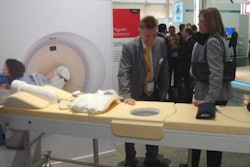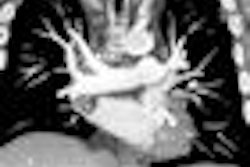VIENNA - A decade's worth of coronary CT angiography (CTA) studies is starting to reveal the modality's long-term predictive powers, if a study from one of Poland's largest heart centers is any indication.
The verdict, according to results in nearly 900 patients scanned seven or so years ago is that coronary CTA not only predicts long-term outcomes, it stratifies patients into low-, intermediate-, and high-risk groups for eventual adverse cardiac events, researchers reported on Friday at the 2010 European Congress of Radiology (ECR).
"We did a study to analyze consecutive patients who were scheduled for coronary angiography for suspicion of coronary artery disease," said Dr. Mieczyslaw Pasowicz from John Paul II Hospital in Krakow, Poland.
Researchers there analyzed data from 899 patients with suspected coronary artery disease (478 men, 421 women; mean age, 59.3 ± 10.1 years) scanned over several months in 2003 and 2004, following the patients for a mean 1,131 ± 377 days for events including cardiac or vascular death, nonfatal myocardial infarction, and nonfatal stroke. Patients with prior coronary artery bypass grafts (CABG) or with contraindications to cardiac CT were excluded.
All patients underwent electrocardiogram-gated coronary CTA on either 16-detector-row (0.75-mm collimation) or 64-detector-row MDCT (0.6-mm collimation) (Somatom Sensation 16 or 64, Siemens Healthcare, Erlangen, Germany) following administration of iodinated contrast.
Data analysis was based on the 17-segment American Heart Association (AHA) model for the severity and presence of luminal narrowing and location and type (noncalcified, mixed, or calcified) of coronary atherosclerotic plaques. Segments smaller than 1.5 mm were excluded, and plaques were classified as obstructive if luminal narrowing was 50% or greater. Events that occurred less than two weeks after a cardiovascular procedure were classified as related to the procedure, Pasowicz said.
The group compared clinical and CTA data to long-term outcomes using the Cox proportional hazards model applied in a stepwise forward fashion to identify predictors of follow-up events. The risk of a variable was expressed by a hazard ratio (HR) with corresponding 95% confidence interval (CI).
During the 1,131-day mean follow-up period, 48 adverse events occurred, including 23 cardiac deaths, five fatal strokes, 17 nonfatal myocardial infarctions, and five nonfatal strokes.
"Patients with events were older, with more diabetes mellitus and more peripheral artery disease, more strokes, and more myocardial infarctions," Pasowicz said. "Patients with events had more plaque and more obstructive plaques, more segments with obstructive plaque, and more mixed plaques."
Plaque number and composition data by MDCT were very important in the model, he added, leading to significant differences in the risks of cardiac events and long-term survival.
Univariate predictors of cardiac events
|
Multivariate predictors of cardiac events
|
Independent predictors of adverse cardiac events were age, prior stroke, prior MI, segments with plaques, and segments with mixed plaques.
"On the Kaplan-Meier curve, we found that patients with events had more significant stenotic lesions, and more multivessel atherosclerotic disease. Patients with more than three plaques and more than two mixed plaques were in a higher risk group," Pasowicz said.
Five-year event-free survival was 99% for normal coronary arteries, 94% for nonobstructive plaque(s), and 92% for obstructive plaques (p < 0.001).
"MDCT predicts outcomes in patients with suspected stenotic lesions or no coronary artery disease," Pasowicz concluded. "This modality may stratify patients into low-, intermediate-, and high-risk groups for major adverse events."
The numbers don't yet include a breakdown of events by individual coronary artery -- that analysis will be performed soon, Pasowicz said in response to a question from the moderator.
By Eric Barnes
AuntMinnie.com staff writer
March 6, 2010
Related Reading
High pitch equals low dose in coronary CT angiography, March 4, 2010
Coronary calcification is a poor gauge of treatment efficacy, December 17, 2009
Symptomatic patients with zero CT calcium scores still have cardiac events, October 2, 2009
Coronary CTA beats calcium scoring for short-term prognosis, August 14, 2009
CTA predicts coronary plaque instability, June 30, 2009
Copyright © 2010 AuntMinnie.com











